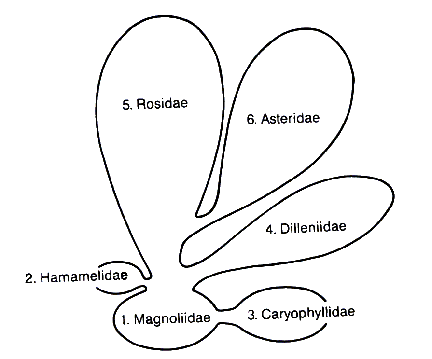 |
The diagram to the left represents one of the various systems
that is used to classify the dicots (often referred to as the Cronquist
system). It separates the dicots into 6 subclasses with supposed
evolutionary relationships to each other illustrated by the "branching"
patterns shown in the diagram. For instance, the Subclass Magnoliidae
is placed in a basal position with the other subclasses branching out from
it. This is meant to suggest that the Magnoliidae is the most ancestral
of the dicot subclasses and that the other subclasses are derived from
it (except for the Asteridae, which would be viewed as having been
derived from the Rosidae).
More recent analyses have shown that this system may not accurately
reflect the true evolutionary relationships within the dicot group.
However potentially inaccurate, the Cronquist system does provide a
convenient means of classification of the less inclusive dicot taxa such
as families, genera, and species. See the table below for the placement
into these subclasses of the dicot families found in Southwest Virginia.
Diagram and subclass membership from: Cronquist, A. 1988.
The
Evolution and Classification of Flowering Plants. 2nd Edition. New
York Botanical Garden, Bronx, New York. |
